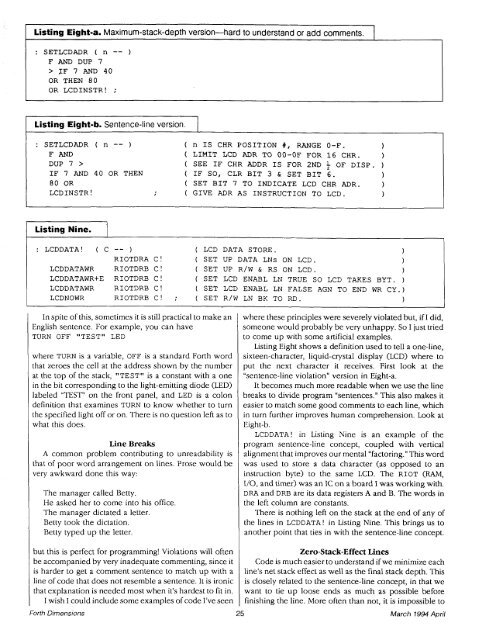FAST Forth Native-Language Embedded Computers
FAST Forth Native-Language Embedded Computers
FAST Forth Native-Language Embedded Computers
Create successful ePaper yourself
Turn your PDF publications into a flip-book with our unique Google optimized e-Paper software.
Listing Eight-a. Maximum-stack-depth version-hard to understand or add comments.<br />
: SETLCDADR ( n -- )<br />
F AND DUP 7<br />
> IF 7 AND 40<br />
OR THEN 80<br />
OR LCDINSTR! ;<br />
Listing Eight-b. Sentence-line version.<br />
: SETLCDADR ( n -- ) ( n IS CHR POSITION #, RANGE O-F. 1<br />
F AND ( LIMIT LCD ADR TO 00-OF FOR 16 CHR. )<br />
DUP 7 > ( SEE IF CHR ADDR IS FOR 2ND $ OF DISP . )<br />
IF 7 AND 40 OR THEN ( IF SO, CLR BIT 3 & SET BIT 6. 1<br />
80 OR ( SET BIT 7 TO INDICATE LCD CHR ADR.<br />
LCDINSTR ! ( GIVE ADR AS INSTRUCTION TO LCD.<br />
Listing Nine.<br />
: LCDDATA! ( C -- ) ( LCD DATA STORE. 1<br />
RIOTDRA C! ( SET UP DATA LNS ON LCD. 1<br />
LCDDATAWR RIOTDRB C! ( SET UP R/W & RS ON LCD. 1<br />
LCDDATAWRtE RIOTDRB C! ( SET LCD ENABL LN TRUE SO LCD TAKES BYT. )<br />
LCDDATAWR RIOTDRB C! ( SET LCD ENABL LN FALSE AGN TO END WR CY.)<br />
LCDNOWR RIOTDRB C! ; ( SET R/W LN BK TO RD. )<br />
In spite of this, sometimes it is still practical to make an<br />
English sentence. For example, you can have<br />
TURN OFF "TEST" LED<br />
where TURN is a variable, OFF is a standard <strong>Forth</strong> word<br />
that zeroes the cell at the address shown by the number<br />
at the top of the stack, "TEST" is a constant with a one<br />
in the bit corresponding to the light-emitting diode (LED)<br />
labeled "TEST" on the front panel, and LED is a colon<br />
definition that examines TURN to know whether to turn<br />
the specified light off or on. There is no question left as to<br />
what this does.<br />
Line Breaks<br />
A common problem contributing to unreadability is<br />
that of poor word arrangement on lines. Prose would be<br />
very awkward done this way:<br />
The manager called Betty.<br />
He asked her to come into his office.<br />
The manager dictated a letter.<br />
Betty took the dictation.<br />
Betty typed up the letter.<br />
but this is perfect for programming! Violations will often<br />
be accompanied by very inadequate commenting, since it<br />
is harder to get a comment sentence to match up with a<br />
line of code that does not resemble a sentence. It is ironic<br />
that explanation is needed most when it's hardest to fit in.<br />
I wish I could include some examples of code I've seen<br />
where these principles were severely violated but, if I did,<br />
someone would probably be very unhappy. So I just tried<br />
to come up with some artificial examples.<br />
Listing Eight shows a definition used to tell a one-line,<br />
sixteen-character, liquid-crystal display (LCD) where to<br />
put the next character it receives. First look at the<br />
"sentence-line violation" version in Eight-a.<br />
It becomes much more readable when we use the line<br />
breaks to divide program "sentences." This also makes it<br />
easier to match some good comments to each line, which<br />
in turn further improves human comprehension. Look at<br />
Eight-b.<br />
LCDDATA! in Listing Nine is an example of the<br />
program sentence-line concept, coupled with vertical<br />
alignment that improves our mental "factoring." This word<br />
was used to store a data character (as opposed to an<br />
instruction byte) to the same LCD. The RIOT (RAM,<br />
11'0, and timer) was an IC on a board I was working with.<br />
DRA and DRB are its data registers A and B. The words in<br />
the left column are constants.<br />
There is nothing left on the stack at the end of any of<br />
the lines in LCDDATA ! in Listing Nine. This brings us to<br />
another point that ties in with the sentence-line concept.<br />
Zero-Stack-Effect Lines<br />
Code is much easier to understand if we minimize each<br />
line's net stack effect as well as the final stack depth. This<br />
is closely related to the sentence-line concept, in that we<br />
want to tie up loose ends as much as possible before<br />
finishing the line. More often than not, it is impossible to<br />
<strong>Forth</strong> Dimensions 25 March 1994 April
















